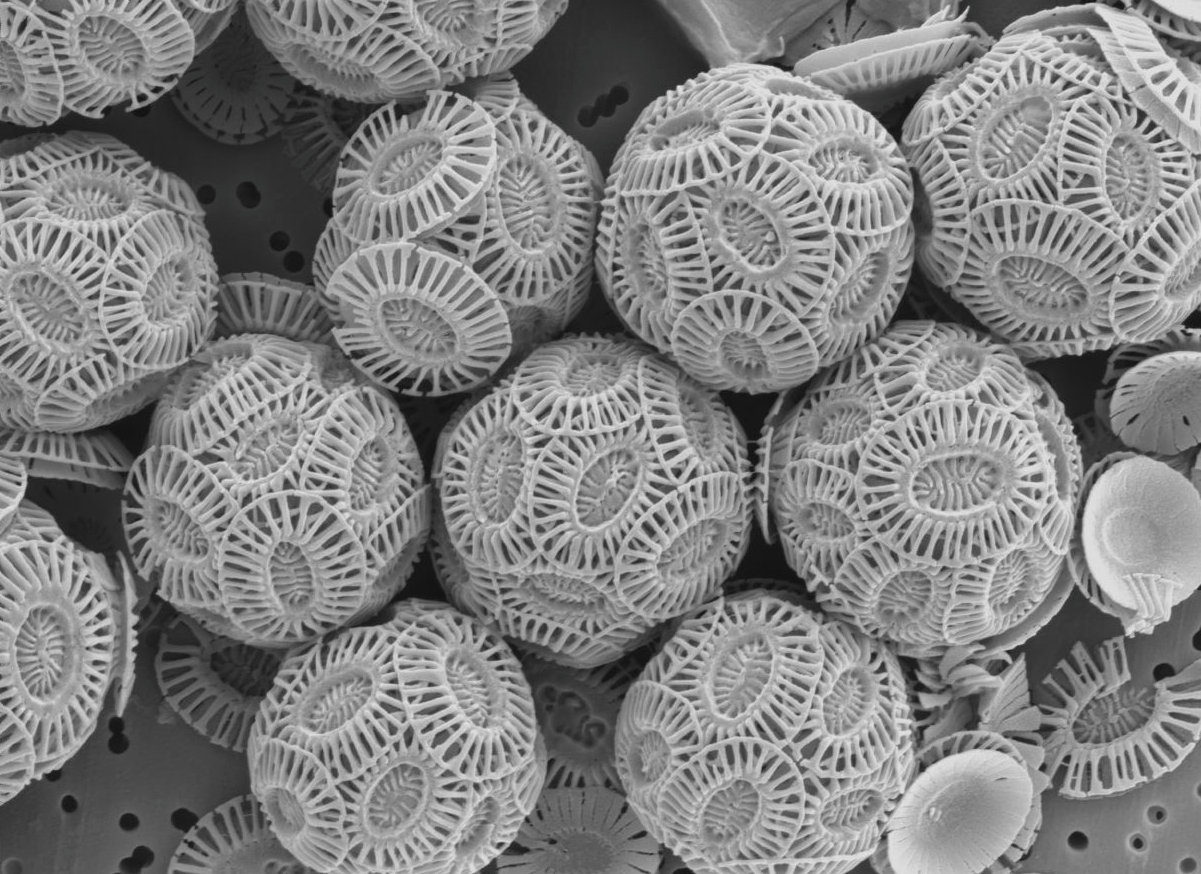story by Helen Hill [1]
 [2]
[2]Coccolithophores, among which Emiliania huxleyi is the most abundant and widespread species, are considered to be the most productive calcifying organism on earth. E. huxleyi often forms massive blooms in temperate and sub-polar oceans, and in particular at continental margins and shelf seas
This month we spotlight recently published work by Fanny Monteiro [3](University of Bristol, UK), Stephanie Dutkiewicz [4] (MIT), and others, who have been using MITgcm to explore the biogeography of a class of phytoplankton with an outsized role to play in the global carbon cycle.
Calcifying marine phytoplankton — coccolithophores — are some of the most successful yet enigmatic organisms in the ocean, however warmer and more acidic oceans associated with global change pose a grave threat. Motivated by the need to better understand how these key players in the global carbon cycle could be affected, Monteiro and collaborators, have been using the MITgcm to explore why coccolithophores calcify in the first place.
In a paper published in Science Advances in July, Monteiro and co-authors share their insights from a suite of numerical experiments geared towards providing a critical assessment of the costs and benefits of calcification.
Calcification puts a high energy demand on an organism. In light of the coccolithophores’ evolutionary history and cell biology, which the paper also reviews, while coccolithphores might have calcified initially to reduce grazing pressure, additional benefits such as protection from photodamage and viral/ bacterial attack may further explain their higher diversity and broad spectrum ecology.
To contrast distributions in a numerical model against real-world observations, Monteiro et al. used a 3D implementation of the MITgcm physical ocean model constrained with satellite and hydrographic observations combined with a plankton functional type ecosystem using five phytoplankton and 2 zooplankton types based on the biogeochemistry and ecosystem model of Dutkiewicz et al. 2014. [5]
While the researchers found that the cost-benefit aspect of these traits were amply illustrated in their model experiments, a lack of observations prevented the researchers from being able to predict how trade-offs between changing ecological and physiological costs associated with calcification might be likely to play out in the face of ocean acidification and global warming.
To find out more about this work contact Fanny [6] or Stephanie [7]
About the Researchers
 [8]
[8]Fanny Monteiro is a NERC Fellow in the School of Geographical Sciences at the University of Bristol. She has been using MITgcm since 2005.
 [9]
[9]Stephanie Dutkiewicz is a principal research scientist at MIT she has been using MITgcm since 1997.
This Month’s Featured Publication
- Fanny M. Monteiro et al. (2016), Why marine phytoplankton calcify [11], Science Advances 13 Jul 2016, Vol. 2, no. 7, e1501822, doi: 10.1126/sciadv.1501822
Other New Publications this Month
Paul, André; Dutkiewicz, Stephanie; Gebbie, Jake; Losch, Martin; Marchal, Olivier (2016), Evaluating the deep-ocean circulation of a global ocean model using carbon isotopic ratios [12], EGU General Assembly 2016, held 17-22 April, 2016 in Vienna Austria, p.12634
Chowdary, J.S., G. Srinivas, T.S. Fousiya, A. Parekh, C. Gnanaseelan, H. Seo, and J.A. MacKinnon (2016), Representation of Bay of Bengal upper-ocean salinity in general circulation models [13], Oceanography 29(2):38–49, doi: 10.5670/ oceanog.2016.37
Darren Engwirda and Maxwell Kelley (2016), A WENO-type slope-limiter for a family of piecewise polynomial methods [14], ArXiv:1606.081.188v1
Gael Forget (2016), ECCO Version 4: Contents And Usage [15], DSpace@MIT, URI: http://hdl.handle.net/1721.1/103367
Erik Fredj, Daniel F. Carlson, Yael Amitai, Avi Gozolchiani, Hezi Gildor (2016), The particle tracking and analysis toolbox (PaTATO) for Matlab [16], Limnology and Oceanography Methods, published online June 10, 2016, doi: 10.1002/lom3.10114
Stephen E. L. Howell, Frédéric Laliberté, Ron Kwok, Chris Derksen, and Joshua King (2016), Landfast ice thickness in the Canadian Arctic Archipelago from observations and models [17], The Cryosphere, 10, 1463–1475, doi: 10.5194/tc-10-1463-2016
Xiaomeng Huang, Qiang Tang, Yuheng Tseng, Yong Hu, Allison H. Baker, Frank O. Bryan, John Dennis, Haohuan Fu, and Guangwen Yang (2016), P-CSI v1.0, an accelerated barotropic solver for the high-resolution ocean model component in the Community Earth System Model v2.0 [18], Geosci. Model Dev. Discuss., doi:10.5194/gmd-2016-135, 2016 Manuscript under review for journal Geosci. Model Dev. Published: 1 July 2016
Jensen, Mari F., Michael A. Spall, Kerim H. Nisancioglu (2016), On the sea-ice cover of the Nordic Seas in an idealized MITgcm-setup [19], EGU General Assembly 2016, held 17-22 April, 2016 in Vienna Austria, p.13925
Paul Kirchgessner, Lars Nerger, Julian Tödter, Bodo Ahrens (2016), High-Dimensional Nonlinear Data Assimilation with the Nonlinear Ensemble Transform Filter (NETF) and its Smoother Extension [20], 5. International Symposium on Data Assimilation, Reading, UK, July 18 – 22, 2016
David Meyer (2016), Glider Technology for Ocean Observations: A Review [21], Ocean Sci. Discuss., doi: 10.5194/os-2016-40, 2016, Manuscript under review for journal Ocean Sci. Published: 1 July 2016
Losa, Svetlana; Bracher, Astrid; Losch, Martin; Oelker, Julia (2016), Investigating the Antarctic phytoplankton in response to environmental changes over the last decades [22], EGU General Assembly 2016, held 17-22 April, 2016 in Vienna Austria, p.16305
L Mariotti, U Utku Turunçoglu, R Farneti, G Sannino et al. (2016), The Regional Earth System Model (RegESM) using RegCM4 coupled with the MITgcm ocean model: First assessments over the MED-CORDEX domain [23], EGU General Assembly 2016, held 17-22 April, 2016 in Vienna Austria, p.4446
Christopher Gilbert Piecuch (2016), Understanding Tide Gauge Mean Sea Level Changes on the East Coast of North America [24], Open Access Dissertations,Paper 472, University of Rhode Island.
Himansu K. Pradhan, A. D. Rao, Sachiko Mohanty (2016), Inter-seasonal variability of internal tides in the western Bay of Bengal [25], Nat. Hazards (2016), doi: 10.1007/s11069-016-2459-x
Isabella Rosso, Andrew McC. Hogg,, Richard Matear, Peter G. Struttond (2016), Quantifying the influence of sub-mesoscale dynamics on the supply of iron to Southern Ocean phytoplankton blooms [26], Deep Sea Research Part I: Oceanographic Research Papers, Volume 115, September 2016, Pages 199–209, doi: 10.1016/j.dsr.2016.06.009
Rye, Craig D. (2016) The response of the Antartic Subpolar Seas to climatic changes [27]. University of Southampton, Ocean & Earth Science, Doctoral Thesis , 149pp., URI: http://eprints.soton.ac.uk/id/eprint/387324
Graeme L. Stephens, Maria Z. Hakuba, Matt Hawcroft, Jim M. Haywood, Ali Behrangi, Jennifer E. Kay, Peter J Webster (2016), The Curious Nature of the Hemispheric Symmetry of the Earth’s Water and Energy Balances [28], Curr. Clim. Change Rep. (2016). doi: 10.1007/s40641-016-0043-9
Bruno Tremble (2016), Convective plumes in rotating systems [29], J. Fluid Mech., vol. 799, pp. 27-55, doi: 10.1017/jfm.2016.348
Vinogradova, Nadya (2016), Ocean water cycle: its recent amplification and impact on ocean circulation [30], EGU General Assembly 2016, held 17-22 April, 2016 in Vienna Austria, p.10692
Zhaomin Wang, Yang Wu, Xia Lin, Chengyan Liu, Zelin Xie (2016), Impacts of open-ocean deep convection in the Weddell Sea on coastal and bottom water temperature [31], Online at Climate Dynamics July 4, doi: 10.1007/s00382-016-3244-y
Alexander Wineteer (2016), Towards Improved Estimates of Upper Ocean Energetics [32], master’s thesis, California Polytechnic State University, San Luis Obispo
Jieshuo Xie, Yinghui He, Haibin Lü, Zhiwu Chen, Jiexin Xu, Shuqun Cai (2016), Distortion and broadening of internal solitary wavefront in the northeastern South China Sea deep basin [33], Online at Geophysical Research Letters July 25, doi: 10.1002/2016GL070093
Ying Zhang, Yan Du , Yuhong Zhang, Shan Gao (2016), Asymmetry of upper ocean salinity response to the Indian Ocean dipole events as seen from ECCO simulation [34], Acta Oceanologica Sinica, July 2016, Volume 35, Issue 7, pp 42-49, doi: 10.1007/s13131-016-0904-z
Do you have news about research using MITgcm? We are looking for contributions to these pages. If you have an interesting MITgcm project (ocean, atmosphere, sea-ice, physics, biology or otherwise) that you want to tell people about, get in touch. To make a post, contact Helen [35]
